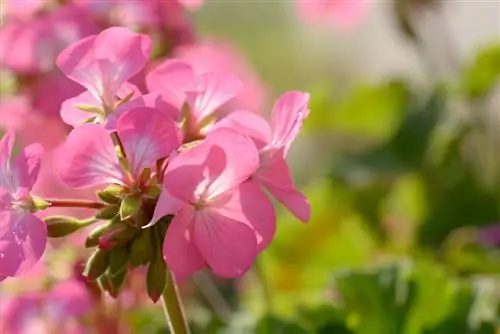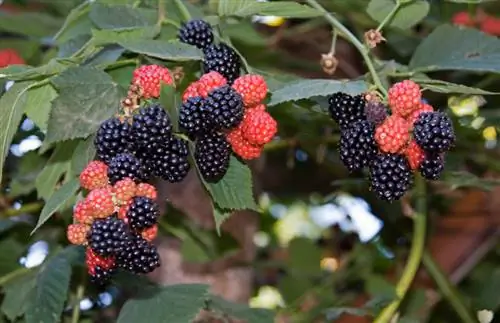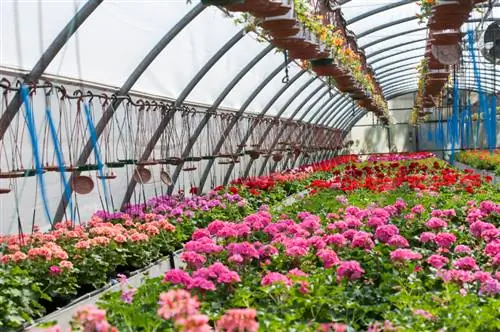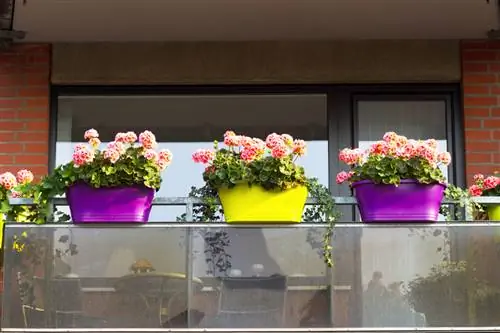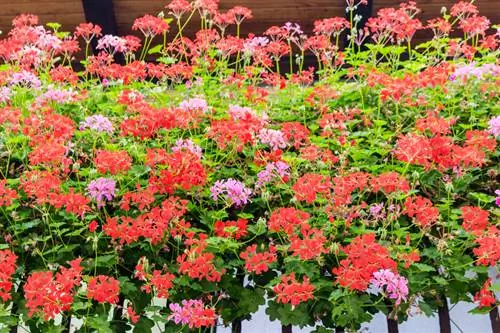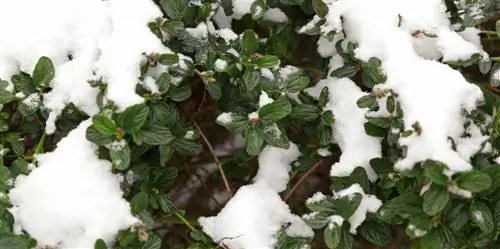- Author admin [email protected].
- Public 2023-12-25 17:45.
- Last modified 2025-06-01 06:02.
The fact that the misleading vernacular term “geranium” has become commonplace for pelargonium can no longer be changed. Just as established as this misnomer is its importance in gardening, especially balcony box culture. Cheers to the pelargonium!
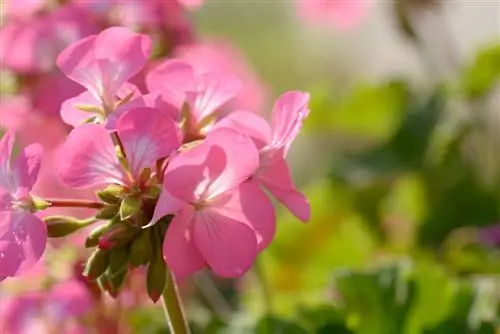
Origin
The foundation for the widespread, although quite well-known, aberration of the name “geranium” instead of the systematically correct “pelargonium” was laid in the course of its introduction into Europe around 1700. Since then, the incorrect, although not entirely unfounded, misnomer has simply become commonplace - a typical phenomenon of linguistic momentum that is resistant to any attempts at correction. The name is not entirely unfounded because pelargonium naturally belongs to the cranesbill family - botanically Geraniaceae. Just like real geraniums, i.e. cranesbills.
Pelargonium was introduced from South Africa - this is also where its main distribution area is concentrated. Around 250 wild species thrive, especially in the southernmost Cape region, but also up to Namibia. However, some also grow in tropical, northern regions of Africa such as Tanzania, Kenya or Zimbabwe. A small group is also native to the Near East from Turkey to Iraq and Iran.
The nature of their original habitat cannot therefore be clearly defined - pelargoniums are adapted to different habitats depending on the species. However, the species we cultivate as garden plants mainly come from southern South Africa, where there is a semi-humid, maritime climate with seasons. In our latitudes they can therefore be cultivated quite easily. However, the winters in their original habitat are much milder than here, which is why long-term outdoor cultivation is not possible here.
The origin of the pelargonium at a glance:
- The species relevant to our garden culture come from southern South Africa
- Are therefore adapted to semi-humid, maritime, seasonal climates
- We get along well, but the winters here are too cold
Growth
Pelargoniums mostly grow as perennials, but there are also annual species and those with a really shrubby habit. There are also succulent species. However, the species we predominantly cultivate are usually perennials. A distinction is made primarily between hanging geraniums, standing geraniums and scented geraniums. The latter show particularly strong, upright, semi-shrub-like growth and lush flowers. But hanging geraniums also grow bushy and have strong shoots. Pelargoniums usually reach a height of around 30 to 40 cm and become slightly woody from below as they age.
Growth characteristics in keywords:
- Pelargoniums cultivated here are mostly perennials
- Bushy, strong growth, upright and semi-shrub-like or overhanging depending on the species
- Growth height about 30 to 40 cm
- Slight woodiness in old age
leaves
The petiolate leaves of pelargoniums have a typically lobed contour and are arranged alternately on the lower shoot sections and oppositely with stipules on the upper sections. In some varieties the foliage is beautifully patterned.
Flowers
The biologically zygomorphic structure of the flowers shows the systematic difference to all other cranesbill plants. The flowers are usually in umbellate groups at the ends or in the shoot axils. Some varieties actually form spherical clusters of flowers. The individual flowers are fivefold and usually have a wide, open flower plate; some varieties also appear a little more delicate with narrower, more elongated petals.
Flower properties in brief:
- Terminal or axillary, usually in umbelous groups
- Zygomorphic structure, fivefold
- Often wide, open flower plates, depending on the variety also more delicate
Colors
Pelargoniums have long been one of the most popular garden and balcony plants and are available in countless varieties - there is by no means a lack of color selection here. Of course, red varieties look particularly classic, but white and pink to violet also make up the color palette. Artful, two-tone varieties with attractive striped or speckled patterns in blue-white or pink-pink are now often offered.read more
When is flowering time?
Pelargoniums have long been valued not only for their lush, colorful and long-distance splendor. The flowers also have a pleasing persistence and decorate the balcony and terrace all summer long with their rustic, rustic charm. The flowering period often lasts from May to September. To ensure vital new growth and a well-groomed flower appearance, you should regularly clean out dead stands.read more
Which location is suitable?
Pelargoniums can be grown both in full sun and in partially shaded places. The more sun they get, the more lush their flowers will be. Because the shoot structure is somewhat fragile, you should not expose it to strong winds. Large-flowered varieties in particular can also be damaged by heavy rain or hail during summer thunderstorms. A location protected from precipitation is not a bad idea.
To remember:
- Location can be sunny to partially shaded
- More flower production with more sun
- Not too strong a wind, some protection from heavy rainfall
read more
What soil does the plant need?
Pelargoniums require fairly nutrient-rich, loose and permeable planting soil. It is not without reason that specialist retailers offer special geranium soil. This is already well pre-fertilized and has good, even water absorption properties and an airy structure.
Of course, marketing geranium soil is also a business - the properties mentioned can also be achieved with the right individual ingredients. The experienced hobby gardener generally mixes his own soil anyway. A pelargonium thrives just as well in universal potting soil, which you provide with a permanent supply of nutrients in the form of good compost and horn shavings as well as a loosening sand content for drainage.
Earth claims in brief:
- Nutrient-rich, loose and permeable
- If you want it to be simple: geranium soil
- But also your own mixtures with universal potting soil, compost, horn shavings and sand are promising
What is the best time to plant?
Since pelargoniums cannot tolerate frost, outdoor cultivation is only possible after the last frosts. This usually means after the Ice Saints in May. However, it is advisable to buy young plants at the end of winter and grow them in a balcony box in a bright, cool place. Place around 5 young plants in fresh, organic long-term fertilized soil in a large balcony box about one meter long and grow them with even watering until mid-May.read more
Balcony
Pelargoniums are the epitome of rustic window and balcony decoration. In fact, a spot close to the house is also ideal for sun worshipers who are slightly sensitive to the weather. In addition, a deep balcony box with sufficient drainage holes is also very suitable as a planter. Here the pelargoniums have enough space for a nutrient-rich planting surface. A hanging position on the balcony railing, if there are enough drainage holes in the balcony box floor, also prevents waterlogging, which pelargoniums cannot tolerate at all.
To promote a high abundance of flowers and willing growth, a south-facing balcony with plenty of sunshine is of course best.read more
Repotting
Pelargoniums can be overwintered indoors - but since they are heavy feeders, you should plant them in a fresh substrate every spring. However, a larger planter than a standard balcony box is usually not necessary due to the generally limited growth size. What is more important is that the new substrate offers a fresh supply of nutrients and of course effective drainage in the form of some sand.read more
Watering geraniums
In general, pelargoniums need a lot of water, but are also very sensitive to waterlogging. It is therefore important to water regularly and extensively, but to ensure effective drainage and good drainage when planting. Always keep a close eye on your pelargoniums in the balcony box and regularly use the watering can, especially during hot, sunny periods in summer. The soil should always be slightly moist, but pelargoniums can also tolerate shorter dry periods.
Fertilize geraniums properly
Apart from the constant supply of organic fertilizer in the potting soil, you should regularly fertilize the nutrient-requiring pelargoniums during the main vegetation phase - at least if you value beautiful, lush flowers. Of course, pelargoniums survive without fertilizer, but then they produce far fewer flowers and more foliage.
You should start fertilizing 2 to 3 weeks after planting. It is best to use a liquid fertilizer for flowering plants. There are also special geranium fertilizers. Add some to the irrigation water once a week or once every 2 to 3 weeks, depending on how the flowers develop.read more
Cut geraniums correctly
No formal pruning measures are necessary during the growth phase over the summer. But regular cleaning is necessary. The dead inflorescences should always be removed quickly so that new ones can grow. The leaves can also become increasingly dry and form a lot of brownish material, which is detrimental to a well-groomed appearance. You can also simply pick out such material by hand.
However, pruning is urgently needed before wintering. Too much plant material remaining requires far too much energy from the plant during hibernation, which can even lead to its death. So trim them down thoroughly.
To do this, take it out of the box and shake off the soil. Then use sharp scissors to cut all the shoots down to about 10 cm so that at least two eyes remain on each. If possible, remove all leaves so as not to leave any plant material that needs unnecessary care and is susceptible to disease - even if the skeleton-like appearance may seem a bit sad afterwards.
If you make the main cut less radical before wintering, you should cut the pelargoniums back a little again in spring when repotting. Here only the dry shoot ends have to be removed in order to promote vital new growth.read more
Frost
Pelargoniums are not frost hardy. In their homeland, the Cape region of South Africa, there is a mild, Mediterranean-like climate with frost-free winters. That's why they don't survive our winter outdoors. However, they do need cool temperatures for the winter months.read more
Wintering
Pelargoniums can easily be overwintered. To do this, take them out of their summer planters in the fall before the first frosts and prepare them for winter rest with a thorough pruning: shorten all shoots except for two eyes and remove all leaves if possible. This means that the plant has less to care for in the low-light, cool period and is less susceptible to diseases and pests.
Put the plants prepared in this way in pots with sandy soil for overwintering and place them in a bright, cool place. The ideal ambient temperature is around 5-10°C. Favorable locations include a bright window seat in an unheated stairwell, a cold house or an attic with a skylight.
To remember:
- Wintering is possible without any problems, with the right preparation measures
- Thorough pruning necessary - shorten all shoots to about 10 cm long
- Remove leaf material
- Place in sandy soil and place in a light and cool place (5-10°C)
read more
Propagate geraniums
Pelagroniums are best propagated via cuttings. Growing seeds is also possible, but very laborious and time-consuming, so not recommended.
It is best to propagate cuttings in early spring or the end of mid-summer. Cut a young, he althy shoot from the mother plant. You should use sharp, clean scissors for this as the interface is somewhat susceptible to rot. The lower leaves and any side shoots are removed. Then place the cutting in a planter with potting soil and water carefully.
The cultivation container should not be particularly bright, but should be relatively warm. The chance of growth is highest in a lightly shaded greenhouse at 20°C. You can also grow the cuttings under foil, but open the foil every now and then to ventilate. Regular moisturizing goes without saying.read more
Cuttings
See section Propagating.read more
Diseases
The topic of diseases is unfortunately quite central when it comes to pelargoniums. They are relatively susceptible to infectious bacterial or viral diseases, some of which are even named after them, such as geranium rust - the most common disease in pelargoniums.
geranium rust
This fungal infection causes the leaves of the geranium to turn yellowish or brownish. Brown spots and pustules may also appear. If you identify the disease, you should remove all diseased parts of the plant as soon as possible because the risk of infection is very high. A fungicide is then the safest choice. The disease is caused by wet leaves - a rain-protected location is therefore recommended.
Pythium mushroom
This is a soil fungus that causes the plant to wilt and reduce growth. The cause of its occurrence is waterlogging. You must immediately remove diseased parts of the plant and replace the substrate. A fungicide application also makes sense.
Cork stains
Cork spots are actually not a disease, but rather tissue scarring on the undersides of the leaves, which occurs when there is too much water, too cold temperatures or too little light. However, cork stains are not dangerous to the pelargonium, they only disturb the aesthetics. So you only need to remove the stained leaves if they bother you.
You can prevent all of these diseases with a sunny, airy location and good drainage.
Pests also attack geraniums relatively often, especially thrisps, aphids or spider mitesread more
Is geranium poisonous?
Pelargonium is harmless to us humans. The flowers of scented geraniums are even edible and are the basis for aromatic culinary delights such as liqueur or flower butter.
However, the sap of pelargoniums contains substances that can cause skin irritation in humans and can even be very dangerous for small animals. Small rodents in particular, such as rabbits, guinea pigs or hamsters, should be kept away from pelargoniums as much as possible.read more
Varieties
The hanging geraniums and the standing geraniums are particularly relevant to our local garden culture. Scented geraniums are also popular, but are mainly kept because of the fragrant, essential oils in their leaves, which can be used to prepare delicious delicacies. The overall variety of varieties is enormous. Here is a selection.
Hanging geraniums
This species is botanically called Pelargonium peltatum and is the absolute classic for balcony box planting. Varieties such as the Tyrolean hanging geranium, which is available in bright, classic colors such as red or white, are very popular because they are robust and attractive. Their shoots reach a length of around 1.50 m - this creates beautiful cascades with lush, tufted, umbellate inflorescences. These appear in May and can last until October.
Very delicate, airy inflorescences are shown by hanging geranium varieties such as “White Glacier”. They also bloom for a long time from May to October. However, their tendrils are not as long as the Tyrolean hanging geraniums, only about 70 cm.
There are also some semi-double or completely double varieties whose flowers look rose-like. They usually grow a little more compactly and are somewhat sensitive to rain because of the ornate flowers.
Standing geraniums
This species, botanically Pelargonium hortorum, shows an upright growth with strong shoots. The varieties often show very colorful flowers in white to pink or orange and grow to a height of around 40 cm.
The Xtreme rose variety is very classic with its large, deep pink flowers that turn pink in the middle and are arranged in loose groups.
There are also varieties with double flowers among the standing geraniums - the “Appleblossom”, for example, delights with numerous small, rose-like flowers in greenish white with a pink exterior, which stand together in dense, ball-like clusters. This variety also flowers continuously from May to October, but requires a lot of cleaning.
fragrant geraniums
If you like to make your own culinary delicacies, you can do a lot with scented geraniums - make liqueurs, prepare flower butter or flavor summer showers. But you can also keep scented geraniums to create a pleasant ambient scent in the summer garden. Another practical advantage: their essential oils keep mosquitoes and pests away, so they are good for us and for neighboring garden plants.
The variety of scented geraniums is immeasurable. You will find variants in countless scents, so you can choose according to your taste. The flowers play a subordinate role in all scented geraniums.
If you have a weakness for citrus scents, varieties such as the lemony-smelling “Lemon Fizz”, the orange-smelling “Prince of Orange” or the finely bitter grapefruit-like “Toronto” are suitable.
Other fruity-smelling varieties include the apricot-like “Madame Nonin” or the fresh, apple-like “Apple Mint”.
Minty-fresh smelling varieties such as “Felty Radens” with a menthol-like, balsamic focus or - for all After Eight fans, “Chocolate Peppermint” with a chocolatey aftertaste. The “Coconut” evokes something exotic and southern.
Varieties such as “Attar of Roses” or “Rosemarie” exude a rosy, elegantly floral odor.

